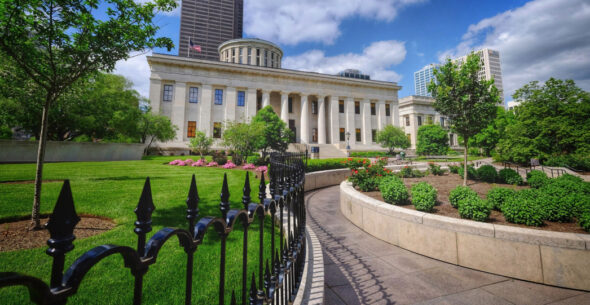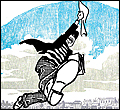
Photo: Ohiohouse.gov
State bills stymie schools, district leaders say
- Published: November 22, 2025
During an Oct. 31 school board work session following the annual State of the Schools address, district leaders called on residents to speak up as state lawmakers advance a slate of bills that will likely restrict local funding for Ohio’s public schools.
In October, the Ohio House approved House Bills 186, 335, 129 and 309. The measures, if passed by the Senate, will affect the calculation of the 20-mill property tax floor and inside millage increases, and give county budget commissions authority to reduce or override voter-approved school levies. All four bills are now before the Ohio Senate’s Local Government Committee.
During the work session, District Treasurer Jacob McGrath said state funding for public schools has repeatedly fallen short in keeping pace with operating costs. He pointed specifically to the biennial budget bill, passed earlier this year, which legislators lauded as having increased public school funding by $226 million over the previous budget; that increase, many school districts have said, is not enough.
“Ten dollars today is not the same as $10 five years ago,” McGrath said. “I think everybody knows that purchasing power goes down every year, so … if you adjust for inflation, state support [for public schools] has only grown by 1% for the last 22 years. Dollars have grown, but percentage-wise, [state funding] has gone down.”
The state shortfall traces back decades: In 1997, the Ohio Supreme Court ruled that the state was failing its constitutional obligation to provide a “thorough and efficient system of common schools” because it relied too heavily on local property taxes. The ruling pushed lawmakers to create the Fair School Funding Plan. Its goal is to better share public education costs between state and local municipalities, and direct more state dollars to communities with lower property tax capacity; however, the plan remains only partially funded.
This year’s budget bill relied on data from 2022 to fund the Fair School Funding Plan, which school districts across the state say has played a part in the bill’s shortfall with regard to funding public schools. At the same time, the state’s share of education funding has shrunk: In 1999, Ohio covered an average of nearly half of the statewide cost to educate students. Today, that average has fallen to 35%. In Yellow Springs, the state shoulders less than the statewide average, and the gap is filled by local dollars.
“Our state share is 23.5%, which means that local taxpayers provide approximately 76.5% percent of our [school district] funding,” McGrath said.
Since 1993, Yellow Springs voters have approved 20 school levies; most were renewal levies, with only eight raising new operating funds. The most recent operating levy passed in 2012. In 2023, voters approved a combination bond issue and new income tax to fund the facilities project, as well as the renewal of a permanent improvement levy. In 2024, voters passed a 10-year substitute levy that combined and continued two previously passed emergency levies.
“So when we talk about voter fatigue, this is one of the things that we’re talking about,” McGrath said. “More than half the time that the school district has been on the ballot has simply been to maintain the funding that we have.”
The bills currently before the Senate, if passed, will affect the way local property taxes are tabulated. The 20-mill floor is the minimum effective school property tax rate a district must collect. Normally, when property values rise, tax rates are reduced to keep revenue steady. But if that reduction would take a district below 20 mills, the 20-mill floor kicks in, requiring the tax rate to rise to 20 mills so revenues keep pace with costs. HB 186 would cap 20-mill floor growth at inflation rather than allowing it to rise commensurate with property values. Another bill, HB 129, would include emergency, substitute and other kinds of levies not currently factored into the 20-mill floor calculation.
The latter bill, if passed, would lift some school districts, including Yellow Springs, off the 20-mill floor, preventing tax rates from increasing as property values rise.
Another focus is inside millage — up to 10 mills that municipalities may levy without voter approval, the revenue from which rises with property values. HB 335 would limit revenue increases to inside millage. At the same time, HB 309 would give county budget commissions authority to reduce collections on previously voter-approved levies after five years.
Though some of the above bills would affect entities other than school districts — Miami Township and the Village of Yellow Springs, for example, split inside millage with the school district and could be subject to levy collection reductions — all four would have the greatest impact on school districts.
The immediate effect of the bills, lawmakers say, will be to ease the burden of rising property taxes for residents. The long-term effect for schools, districts around the state say, will be a quandary: With the state still contributing less than half of most school districts’ costs, those districts will still heavily rely on local property taxes, but with increased restrictions. District leaders said public schools will essentially be caught between a rock and a hard place: Ask voters to return to the polls more often to approve more revenue, or cut costs and, thus, services to students?
McGrath said that, though most folks agree there is a need to cap growth on property taxes, the state’s pending bills threaten the stability of public school districts.
“We knew this was coming,” McGrath said. “The state reducing the amount of money that they are giving the schools is a tax increase for local residents across the state; everybody is going to have to pay more to keep their schools.”
Superintendent Terri Holden said the district is also concerned about legislative discussions around eliminating property taxes entirely through a constitutional amendment — a change Holden said would be “catastrophic” for school districts.
“We need property tax relief,” Holden said, “but thoughtful property tax relief and not property tax relief on the backs of our students and on the backs of our communities who value their public schools.”
McGrath added that the district needs help making sure lawmakers hear local concerns.
“This is where we’re going to ask you for your help,” McGrath said. “If you’re concerned about these things, what you can do is talk to your legislators.”
Contact: chuck@ysnews.com
The Yellow Springs News encourages respectful discussion of this article.
You must login to post a comment.
Don't have a login? Register for a free YSNews.com account.

















No comments yet for this article.